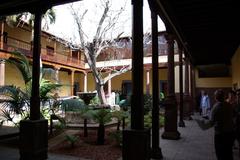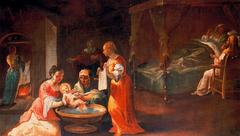Complete Guide to Palacete Rodríguez De Azero: Visiting Hours, Tickets, and Attractions in San Cristóbal De La Laguna
Date: 14/06/2025
Introduction
Located in the vibrant heart of San Cristóbal De La Laguna—a UNESCO World Heritage Site on Tenerife—the Palacete Rodríguez De Azero stands as a testament to the city’s architectural grandeur and evolving cultural tapestry. Built in the early 20th century by the influential Rodríguez de Azero family, the palacete is a striking example of eclectic architecture, integrating French Second Empire, Neo-Pompeian, Italianate, and Neo-Mudejar styles. Today, it is more than a historic residence: it is a living cultural hub, home to the Casino de La Laguna, and a focal point for concerts, exhibitions, and community life (GPSmyCity; Turismo La Laguna; Web Tenerife).
This guide details the palacete’s history, architectural highlights, community significance, and provides practical visitor information on hours, tickets, tours, accessibility, and nearby attractions—ensuring a well-prepared and enriching visit.
Table of Contents
- Introduction
- Historical Context
- Architectural Highlights
- Cultural and Community Role
- Visitor Experience
- Nearby Attractions
- FAQ
- Conclusion
- References
Historical Context
Origins and Early Ownership
Constructed in 1904, the Palacete Rodríguez De Azero reflects the social and economic transformation of La Laguna at the turn of the 20th century. The Rodríguez de Azero family, prominent in local aristocracy and business, sought to embody their cosmopolitan aspirations through this eclectic residence. Their investment paralleled a broader trend among affluent families, blending Canarian tradition with European styles in the city’s urban core (GPSmyCity).
Socio-Political Significance
The palacete’s construction coincided with a period of modernization in the Canary Islands marked by infrastructural growth and increased contact with mainland Europe. The residence became a gathering place for intellectuals, politicians, and artists, and during the Spanish Civil War, it was temporarily repurposed for administrative use. Restoration and heritage efforts in the late 20th century secured its place in the city’s historical narrative.
Preservation and Heritage Status
Recognized for its architectural and cultural value, the palacete is a protected asset under Canary Islands law and is included in the UNESCO World Heritage designation for San Cristóbal De La Laguna (UNESCO; Ayuntamiento de La Laguna). Restoration efforts have balanced preservation of original features with adaptation for public and cultural uses.
Architectural Highlights
Eclecticism and European Influences
The palacete’s design merges French Second Empire symmetry and mansard roofs, Italianate details, Neo-Mudejar influences, and modernist ironwork. The façade features volcanic stone, ornate cornices, and striking wrought-iron balconies. Its architectural language was a statement of both status and modernity for its original owners (Turismo La Laguna; Web Tenerife).
Interior Layout and Decorative Arts
Inside, a central hall illuminated by a stained-glass skylight leads to period-furnished salons with carved wooden ceilings, marble fireplaces, and decorative tilework. A grand staircase, pastel color palette, and gold leaf accents reflect early 20th-century European taste.
Gardens and Exterior Spaces
The palacete is set within French parterre gardens, featuring geometric flowerbeds, fountains, and mature palms. The gardens create a tranquil buffer from the city and enhance the building’s visual appeal.
Restoration and Adaptive Reuse
Restoration projects have preserved original materials and introduced climate control for art conservation. Today, the building hosts exhibitions, concerts, and civic events, ensuring continued public engagement (Ayuntamiento de La Laguna).
Cultural and Community Role
The Casino de La Laguna
The palacete serves as the seat of the Casino de La Laguna—a private social club and cultural venue. The casino is not a gambling hall but a community gathering place for concerts, art exhibitions, and lectures. Its open days and events allow locals and visitors to experience its historic ambiance (Turismo La Laguna).
Urban Modernization and Civic Pride
Commissioned during a period of urban renewal, the palacete symbolized the aspirations of La Laguna’s elite and has since become a civic icon, representing the city’s blend of tradition and innovation (Patrimonio Mundial La Laguna).
Educational and Local Engagement
The palacete is featured in guided tours and educational programs, helping foster appreciation for local history and architecture among residents and students (Guide to Canary Islands).
Preservation and Accessibility
Restoration has included accessibility improvements such as ramps and adapted restrooms. Tours are available in multiple languages, and the city’s broader accessibility initiatives ensure inclusive experiences for all visitors (Turismo La Laguna).
Integration with Historic Center
The palacete is centrally located near Plaza del Adelantado, the Cathedral, and other landmarks, making it a highlight of city walking tours and cultural itineraries (Guide to Canary Islands; Barceló Guide).
Visitor Experience
Visiting Hours and Ticketing
- General Hours: Tuesday to Sunday, 10:00 AM – 6:00 PM. Closed Mondays and on major public holidays.
- Tickets: Entry is generally free for public events and bar-cafeteria access. Guided tours may require a nominal fee; advance booking is advised for groups or during peak seasons. Always check the official website before your visit for up-to-date information (Web Tenerife).
Guided Tours and Special Events
Regular guided tours include the palacete as part of city walking itineraries, offering rich historical and architectural insights. The palacete also hosts music, art, and community events—details are posted on official tourism channels.
Accessibility
The palacete and its immediate surroundings are accessible for visitors with reduced mobility, with ramped entrances and adapted facilities. The broader city center is pedestrian-friendly, with accessible public transport and support services (EU Access City Award 2024 recipient).
Location and Getting There
The palacete is located at Calle Nava y Grimón, 7, just off Plaza del Adelantado. It is reachable on foot from most historic sites, by public tram or bus (with regular service from Tenerife Norte Airport), or by car (parking is limited in the historic center). Taxis are available at nearby Plaza del Adelantado.
Amenities and Travel Tips
- Food & Drink: The palacete’s own bar-cafeteria and numerous cafés and restaurants are nearby.
- Restrooms & Info Points: Public facilities and tourist information are conveniently found in the city center.
- Best visiting times: Morning hours and weekdays tend to be quieter.
- Language: Spanish is official, but English is widely spoken in tourism settings.
- Dress code: Smart-casual attire is suggested for events.
- Photography: Permitted in public areas unless otherwise posted.
Nearby Attractions
- Plaza del Adelantado: Central square, surrounded by key civic and religious buildings.
- Palacio de Nava: Striking architectural blend from 1585.
- Monastery of Santa Catalina de Siena: Notable for its Renaissance cloister.
- Casa de los Capitanes Generales: Historic mansion with cultural events.
- Cathedral of San Cristóbal de La Laguna: Major religious and historic landmark.
- Casa Salazar: Renowned for its ornate stonework.
- Teatro Leal: Modernist theater hosting frequent performances.
- La Laguna Market: Local produce and crafts in Plaza del Cristo.
Frequently Asked Questions (FAQ)
Q: What are the visiting hours for the Palacete Rodríguez De Azero?
A: Tuesday–Sunday, 10:00 AM–6:00 PM; confirm with official sources before visiting.
Q: Are tickets required?
A: Admission is usually free for public areas and events; guided tours may have a small fee.
Q: Is the palacete accessible?
A: Yes, including ramps and adapted restrooms; the city center is also accessible.
Q: Are guided tours available in English?
A: Yes, tours are offered in several languages; advance booking is recommended.
Q: What is the best way to reach the palacete?
A: On foot from the city center or by public transport; limited parking is available.
Visuals and Media
High-quality images and virtual tours are available on official tourism sites, offering views of the palacete’s façade, interiors, and gardens. Images include descriptive alt text such as “Palacete Rodríguez De Azero visiting hours” and “San Cristóbal De La Laguna historical sites.”
Conclusion
The Palacete Rodríguez De Azero is both an architectural jewel and a living center of cultural life in San Cristóbal De La Laguna. With its blend of historic elegance and contemporary community engagement, it invites visitors to experience the city’s evolution from colonial capital to modern cultural hub. Plan your visit to enjoy guided tours, cultural events, and the vibrant urban setting—making the most of this unique heritage site. For further updates, download the Audiala app, follow local tourism channels, and explore additional resources on La Laguna’s historic attractions.
References
- GPSmyCity – San Cristóbal De La Laguna: UNESCO World Heritage Site
- Turismo La Laguna – Palacete Rodríguez De Azero
- Web Tenerife – Palacete Rodríguez De Azero
- UNESCO – San Cristóbal De La Laguna World Heritage Listing
- Ayuntamiento de La Laguna – Official Website
- Patrimonio Mundial La Laguna – Cultural Heritage Information
- Web Tenerife – Visitor Information
- Guide to Canary Islands – Things to Do in San Cristóbal de La Laguna
- Barceló Guide – What to See in La Laguna

